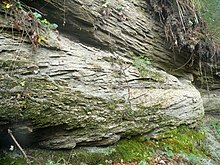Hatred Mountains Formation


The Hassberge Formation (formerly Kieselsandstein, Kieselsandstein layers, Blasensandstein i. W. S., Coburg Sandstone) is a lithostratigraphic formation of the Keuper in the Germanic Triassic . The lithostratigraphic unit is underlain by the Steigerwald Formation and overlaid by the Mainhardt Formation .
definition
The lower limit of the Hassberge Formation is defined with the onset of the sandstones of the bubble sandstone. However, the limit is a diachronic facies limit. The upper limit is defined by the exposure of the sandstones. The maximum thickness is about 75 m (about northwest of Bamberg). Otherwise thicknesses of around 40 to 50 m are achieved. The formation wedges continuously to 0 m to the southwest. The Hassberge formation is limited to the edge of the Germanic Basin towards the Vindelizisches Land . The dovetailed basin with the Weser formation . The Hassberge formation is dated to the Carnian ( Tuvalian ) of the Upper Triassic . The type profiles are in the quarries near Ebelsbach and Schönbachsmühle . The type region are the Hassberge in Franconia , after which the Hassberge formation is also named.
structure
The Hassberge formation has not yet been formally divided into sub-formations. However, there is a lithological subdivision into
- Coburger Bausandstein (Upper Silica Sandstone) and
- Bubble sandstone (lower silica sandstone).
These units could therefore get the rank of subformations.
Storage room
The sandstones of the Hassberge Formation were deposited in a river system. The massive sandstones were deposited in river channels that interlock with flood sediments. Limestone banks were also deposited locally in these flood plains.
Fossils
The sandstones and clay layers contain plant remains (e.g. Voltziales ), arthropods (Conchostraken, Triopsiden and insects), vertebrate remains ("reptiles", amphibians and fish ) as well as numerous tracks from larger vertebrates and other Ichnotaxa . The triopsids from the Coburg sandstone of the Steigerwald in Franconia are still counted by some authors to be among the oldest fossils that have so far been found of a "recent species". They are "Tadpole Shrimp" of the species Triops cancriformis , which Ferdinand Trusheim discovered for the first time in the late 1930s and which was listed as a subspecies T. c. minor described were.
literature
- Gerhard Beutler: Lithostratigraphy. In: German Stratigraphic Commission (Ed.): Stratigraphie von Deutschland IV - Keuper. Courier Forschungsinstitut Senckenberg, 253: 65-84, Stuttgart 2005 ISSN 0341-4116
- Gerhard Beutler, Norbert Hauschke, Edgar Nitsch: Facies development of the Keuper in the Germanic basin. In: Norbert Hauschke, Volker Wilde (Hrsg.): Trias - A whole different world of Central Europe in the early Middle Ages. Pp. 129–174, Verlag Dr. Friedrich Pfeil, Munich 1999 ISBN 3-931516-55-5
- Edgar Nitsch: The Keuper in the Stratigraphic Table of Germany 2002: Formations and consequences. Newsletters on Stratigraphy, 41 (1-3): 159-171, Stuttgart 2005 ISSN 0078-0421
Web links
- German Stratigraphic Commission (Ed.): Stratigraphische Tisch von Deutschland 2002 . Potsdam 2002, ISBN 3-00-010197-7 - PDF; 6.57 MB (large) (abbreviated STD2002)
Individual evidence
- ^ Ferdinand Trusheim: Triopsiden (Crust. Phyll.) From the Keuper Franconia. Paleontological Journal. Vol. 19, No. 3-4, 1938, pp. 198-216, doi : 10.1007 / BF03042241
- ↑ Klaus-Peter Kelber: Triops cancriformis (Crustacea: Notostraca): A remarkable fossil from the Triassic Central Europe. In: Norbert Hauschke, Volker Wilde: Trias - A completely different world. Publishing house Dr. Friedrich Pfeil, Munich 1999, ISBN 978-3-931516-55-0 , pp. 383-394 (digital copy: PDF 13.9 MB)
